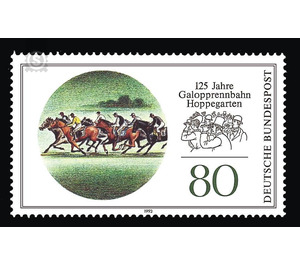125 years hoppegarten racecourse near berlin - Germany / Federal Republic of Germany 1993 - 80 Pfennig
Theme: Animals
| Country | Germany / Federal Republic of Germany |
| Issue Date | 1993 |
| Face Value | 80.00 |
| Color | green white |
| Perforation | K 13 3/4: 14 |
| Printing Type | Multicolor offset printing |
| Stamp Type | Postage stamp |
| Item Type | Stamp |
| Chronological Issue Number | 1550 |
| Chronological Chapter | GER-BRD |
| Michel ID | BRD 1677 |
| SID | 948202 |
| In 52 Wishlists | |
Carl Bohm is the real architect of this gem. Before Bohm conceived the details of Hoppegarten, he drove to Paris-Longchamp and Chantilly. Heinrich von Treskow-Dahlwitz provided the site to the Union Club at the time. Dahlwitz-Hoppegarten is today the correct place name of this unusual hippodrome. On October 9, 1867 (trial) the first day of the race was held there, the official opening followed on May 17, 1868 in the presence of the king, his ministers and Chancellor Otto von Bismarck. In the best of times, 1,500 horses were trained in Hoppegarten, today it is about 440. The finish line is 550 meters long, the track 30 meters wide. The grandstand holds around 4,000 visitors. The Prussian Minister of War Samuel von Marschall established the Vorwerk Hoppegarten in the years 1722 to 1734, he was lord of the estate on Dahlwitz, 1850 Heinrich von Treskow came into the possession. He himself has been actively involved in the construction of the racetrack. 29,000 meters of grass training lanes were available, 16,000 meters of sand track, a total of 45 kilometers. The training as well as the race track found the admiration of even spoiled and widely traveled guests from abroad. In the Turf Hoppegarten was one of the most important destinations, as it was home to many of the most important races, especially Henckel races, Black Gold races, the Diana Prize, the Golden Whip, the Grand Prix of the Reich capital and the Union race. The Second World War had also hit Hoppegarten hard. On April 14, 1946, the first race day was held after the end of the war. In the following years Hoppegarten disappeared from the international scene. On November 11, 1989, the last race day of the old decade took place in Hoppegarten. The first German-German race day was held with a grand party on March 31, 1990, and the viewer ratings ranged between 45,000 and 50,000. In the 1991 season, the racing administration on the railways in eastern Germany became the responsibility of the umbrella organization in Cologne. In the first year of the unified German states, Hoppegarten became one of the train with the most visitors. Almost 300,000 people from all walks of life found their way to one of the most beautiful Turfarenen on our continent on 18 days of racing. This positive trend continued in 1992. In the sporting sector, four European Group III competitions set the highest international accents. Hoppegarten is living up to its reputation of being a top European destination. Many sponsors have contractually promised their financial support for another year, so that the performance of the horse races on the beautiful parking area is secured on the outskirts of Berlin.
| Condition | Name | In Stock | Price | Price + Shipping | Store | |
|---|---|---|---|---|---|---|
 | Unmounted Mint ** | 125 years hoppegarten racecourse near berlin - Germany / Federal Republic of Germany 1993 - 80 Pfennig | 7 | US $0.87 | US $4.12 |  FILATELIELOKET (0) FILATELIELOKET (0)Shipping US $3.25 Minimum Order US $2.72 |


